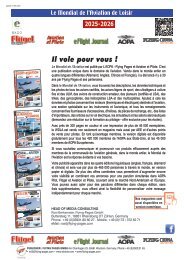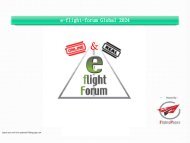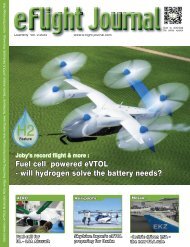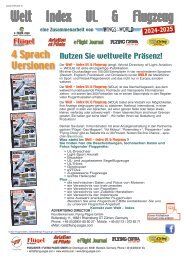eFlight Journal 02-2020
E-Flight Journal 2-2020
E-Flight Journal 2-2020
- No tags were found...
You also want an ePaper? Increase the reach of your titles
YUMPU automatically turns print PDFs into web optimized ePapers that Google loves.
Cover News Story<br />
Bye Aerospace received 10 million USD new investment<br />
Bye Aerospace, developer of the all-electric eFlyer family<br />
of FAA Part 23-certified aircraft, announced completion<br />
of a $5 million strategic investment by a venture capital<br />
group earlier this year. The successful investment was<br />
soon followed by the completion of a $5 million venture<br />
raise. Bye noted that although the two financial transactions<br />
successfully closed during coronavirus restrictions,<br />
much of the due diligence and planning was completed<br />
before the Covid-19 pandemic escalated. George E.<br />
Bye, CEO, of Bye Aerospace, said the investments have<br />
allowed Bye Aerospace to begin work on “Serial #001,”<br />
the first production-conforming prototype of its two-seat<br />
eFlyer 2 aircraft. Chrysanthe Gussis, a Bay Area green<br />
tech investor, finance expert and a member of Bye Aerospace’s<br />
strategic advisory board, said, “Electric flight<br />
is the future of air travel, and even more so now following<br />
the coronavirus outbreak, especially as the demand<br />
for affordable, smaller, greener aircraft increases. We<br />
are seeing more investors recognize the vision of Bye<br />
Aerospace as a leader in this sector.” Previously, in late<br />
2018 Bye Aerospace completed a major investment by<br />
SUBARU-SBI Innovation Fund.<br />
Former Airbus Vahana team members founded eSTOL project<br />
The former chief strategy<br />
officer of Airbus Vahana<br />
eVTOL demonstrator<br />
project, Marc<br />
Ausman, led four core<br />
technical members of<br />
the Vahana project to<br />
establish an electric aircraft<br />
startup company<br />
named “Airflow”. It<br />
is an electric short-distance<br />
take-off and landing<br />
model (eSTOL). The<br />
goal is to target the urban air transportation market, including<br />
logistics and passenger transportation. The design<br />
specifications of the aircraft are single pilot, 500<br />
pounds’ payload (227 kg), 150 feet take-off and landing<br />
distance (45 meters), 250 miles range (400 kilometers),<br />
90 cubic feet of cargo space (2.5 cubic meters).The com-<br />
pany will utilize three key technologies: electric distributed<br />
propulsion (DEP) to significantly reduce the takeoff<br />
and landing distance, computer-aided flight control<br />
to reduce the work load of the pilot, and fleet management<br />
system.<br />
10 e Flight <strong>Journal</strong><br />
2 / 2<strong>02</strong>0
















